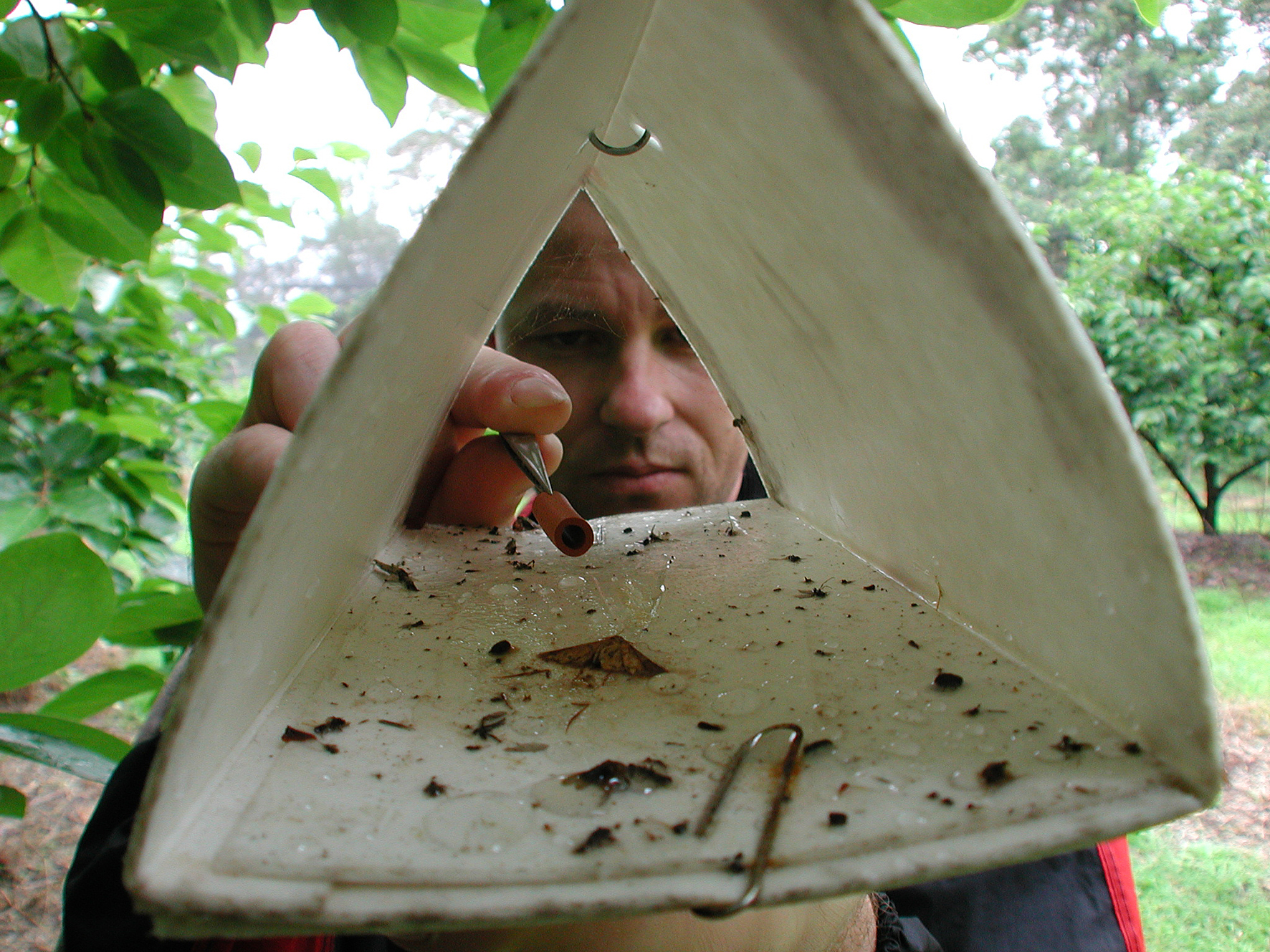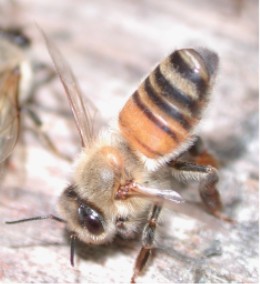Chemical Communication In Insects on:
[Wikipedia]
[Google]
[Amazon]
 Chemical communication in insects is social signalling between
Chemical communication in insects is social signalling between
 Pheromones are of two main kinds: primer pheromones, which generate a long-duration change in the insect that receives them, or releaser pheromones, which cause an immediate change in behaviour. Primers include the queen pheromones essential to maintain the caste structure of social Hymenopteran colonies; they tend to be non-volatile and are dispersed by workers across the colony. In some ants and wasps, the queen pheromones are
Pheromones are of two main kinds: primer pheromones, which generate a long-duration change in the insect that receives them, or releaser pheromones, which cause an immediate change in behaviour. Primers include the queen pheromones essential to maintain the caste structure of social Hymenopteran colonies; they tend to be non-volatile and are dispersed by workers across the colony. In some ants and wasps, the queen pheromones are  Eusocial insects including ants, termites, bees, and social wasps produce pheromones from several types of
Eusocial insects including ants, termites, bees, and social wasps produce pheromones from several types of
 Chemical communication in insects is social signalling between
Chemical communication in insects is social signalling between insect
Insects (from Latin ') are Hexapoda, hexapod invertebrates of the class (biology), class Insecta. They are the largest group within the arthropod phylum. Insects have a chitinous exoskeleton, a three-part body (Insect morphology#Head, head, ...
s of the same or different species
A species () is often defined as the largest group of organisms in which any two individuals of the appropriate sexes or mating types can produce fertile offspring, typically by sexual reproduction. It is the basic unit of Taxonomy (biology), ...
, using chemicals. These chemicals may be volatile, to be detected at a distance by other insects' sense of smell, or non-volatile, to be detected on an insect's cuticle by other insects' sense of taste. Many of these chemicals are pheromone
A pheromone () is a secreted or excreted chemical factor that triggers a social response in members of the same species. Pheromones are chemicals capable of acting like hormones outside the body of the secreting individual, to affect the behavio ...
s, acting like hormone
A hormone (from the Ancient Greek, Greek participle , "setting in motion") is a class of cell signaling, signaling molecules in multicellular organisms that are sent to distant organs or tissues by complex biological processes to regulate physio ...
s outside the body.
Among the many functions of chemical communication are attracting mates, aggregating conspecific
Biological specificity is the tendency of a characteristic such as a behavior or a biochemical variation to occur in a particular species.
Biochemist Linus Pauling stated that "Biological specificity is the set of characteristics of living organism ...
individuals of both sexes, deterring other individuals from approaching, announcing a new food source, marking a trail, recognizing nest-mates, marking territory and triggering aggression.
Chemical communication within a species can be usurped by other species in chemical mimicry
Chemical mimicry (or molecular mimicry) is a type of biological mimicry involving the use of chemicals to dupe an operator.
A chemical mimic dupes an operator (e.g. a predator) by showing an adaptive chemical resemblance to an object of its envi ...
. The mimic produces allomones or pheromones to influence the behaviour of another insect, the dupe, to the mimic's advantage. The process is important in ant mimicry
Ant mimicry or myrmecomorphy is mimicry of ants by other organisms; it has evolved over 70 times. Ants are abundant all over the world, and potential predators that rely on vision to identify their prey, such as birds and wasps, normally avoid t ...
where species that do not look like ants are accepted into the ant colony.
History of research
In 1960, Dethier, Brown, and Smith categorised chemical signals into six groups. In 1965, the entomologist Edward O. Wilson published a paper on chemical communication in thesocial insects
Eusociality (Greek 'good' and social) is the highest level of organization of sociality. It is defined by the following characteristics: cooperative brood care (including care of offspring from other individuals), overlapping generations with ...
, arguing that their societies were principally organised by "complex systems of chemical signals". By 1990, Mahmoud Ali and David Morgan noted that the field had grown too large to review comprehensively.
Semiochemicals
In addition to the use of means such as making sounds, generating light, and touch for communication, a wide range of insects have evolved chemical signals,semiochemical
A semiochemical, from the Greek wiktionary:σημεῖον, σημεῖον (''semeion''), meaning "signal", is a chemical substance or mixture released by an organism that affects the behaviors of other individuals. Semiochemical communication c ...
s. Types of semiochemicals include pheromone
A pheromone () is a secreted or excreted chemical factor that triggers a social response in members of the same species. Pheromones are chemicals capable of acting like hormones outside the body of the secreting individual, to affect the behavio ...
s and kairomone
A kairomone is a semiochemical released by an organism that mediates interspecific interactions in a way that benefits a different species at the expense of the emitter. Derived from the Greek καιρός, meaning "''opportune moment""kairomon ...
s. Chemoreception
A chemoreceptor, also known as chemosensor, is a specialized sensory receptor which transduces a chemical substance (endogenous or induced) to generate a biological signal. This signal may be in the form of an action potential, if the chemorecept ...
is the physiological response of a sense organ to a chemical stimulus where the chemicals act as signals to regulate the state or activity of a cell.
Semiochemicals are often derived from plant metabolites. They can be grouped by which individuals they act upon:
* Pheromone
A pheromone () is a secreted or excreted chemical factor that triggers a social response in members of the same species. Pheromones are chemicals capable of acting like hormones outside the body of the secreting individual, to affect the behavio ...
s serve communication between insects of the same species.
* Allomone
An allomone (from Ancient Greek ' "other" and pheromone) is a type of semiochemical produced and released by an individual of one species that affects the behaviour of a member of another species to the benefit of the originator but not the rec ...
s benefit their producer by the effect they have upon the receiver.
* Kairomones benefit their receiver instead of their producer.
* Synomones benefit the producer and the receiver.
While some chemicals are targeted at individuals of the same species, others are used for communication across species. The use of scents is especially well-developed in social insects. Cuticular hydrocarbons are nonstructural materials produced and secreted to the cuticle
A cuticle (), or cuticula, is any of a variety of tough but flexible, non-mineral outer coverings of an organism, or parts of an organism, that provide protection. Various types of "cuticle" are non- homologous, differing in their origin, structu ...
surface to fight desiccation
Desiccation is the state of extreme dryness, or the process of extreme drying. A desiccant is a hygroscopic (attracts and holds water) substance that induces or sustains such a state in its local vicinity in a moderately sealed container. The ...
and pathogen
In biology, a pathogen (, "suffering", "passion" and , "producer of"), in the oldest and broadest sense, is any organism or agent that can produce disease. A pathogen may also be referred to as an infectious agent, or simply a Germ theory of d ...
s. They are important, too, as pheromones, especially in social insects
Eusociality (Greek 'good' and social) is the highest level of organization of sociality. It is defined by the following characteristics: cooperative brood care (including care of offspring from other individuals), overlapping generations with ...
.
Pheromones
cuticular hydrocarbons
Insects (from Latin ') are hexapod invertebrates of the class Insecta. They are the largest group within the arthropod phylum. Insects have a chitinous exoskeleton, a three-part body (head, thorax and abdomen), three pairs of jointed legs, ...
.
 Eusocial insects including ants, termites, bees, and social wasps produce pheromones from several types of
Eusocial insects including ants, termites, bees, and social wasps produce pheromones from several types of exocrine gland
Exocrine glands are glands that secrete substances onto an epithelial surface by way of a duct. Examples of exocrine glands include sweat, salivary, mammary, ceruminous, lacrimal, sebaceous, prostate and mucous. Exocrine glands are one of ...
. These include mandibular glands in the head, and Dufour's, tergal, and other glands in the abdomen.
Mimicry
Chemical communication within a species can be usurped by other species inchemical mimicry
Chemical mimicry (or molecular mimicry) is a type of biological mimicry involving the use of chemicals to dupe an operator.
A chemical mimic dupes an operator (e.g. a predator) by showing an adaptive chemical resemblance to an object of its envi ...
. The mimic produces allomones or pheromones to influence the behaviour of another insect, the dupe, to the mimic's advantage.
The type of mimicry
In evolutionary biology, mimicry is an evolved resemblance between an organism and another object, often an organism of another species. Mimicry may evolve between different species, or between individuals of the same species. In the simples ...
can be Batesian, in which the mimic gains protection by resembling a harmful insect;
it can also be Müllerian, in which different well-defended insects resemble each other, in this case chemically, to minimise losses to predators;
aggressive
Aggression is behavior aimed at opposing or attacking something or someone. Though often done with the intent to cause harm, some might channel it into creative and practical outlets. It may occur either reactively or without provocation. In h ...
, enabling a predatory mimic to approach its prey;
or reproductive, as in Pouyannian mimicry
Pouyannian mimicry is a form of mimicry in plants that deceives an insect into pseudocopulation, attempting to copulate with a flower. The flower mimicry, mimics a potential female mate of a male insect, which then serves the plant as a pollina ...
, when an orchid
Orchids are plants that belong to the family Orchidaceae (), a diverse and widespread group of flowering plants with blooms that are often colourful and fragrant. Orchids are cosmopolitan plants that are found in almost every habitat on Eart ...
chemically (and visually) resembles a pollinator such as a bee or wasp, which tries to copulate with the flower, transferring pollen in the process.
It occurs, too, in ant mimicry
Ant mimicry or myrmecomorphy is mimicry of ants by other organisms; it has evolved over 70 times. Ants are abundant all over the world, and potential predators that rely on vision to identify their prey, such as birds and wasps, normally avoid t ...
, where a mimic such as a butterfly larva is enabled to live within a colony of ants, that would otherwise kill it, by producing antlike semiochemicals.
Human uses of pheromones
Human uses of pheromones include their application instead of insecticides inorchard
An orchard is an intentional plantation of trees or shrubs that is maintained for food production. Orchards comprise fruit tree, fruit- or nut (fruit), nut-producing trees that are generally grown for commercial production. Orchards are also so ...
s. Pest insects such as fruit moths are attracted by sex pheromones, allowing farmers to evaluate pest levels, and if need be to provide sufficient pheromone to disrupt mating.
References
{{Animal communication Animal communication Insect physiology